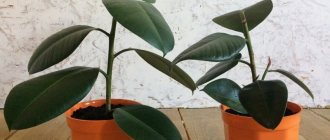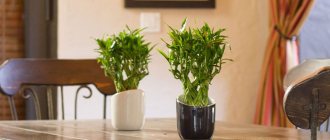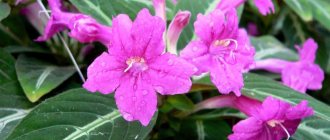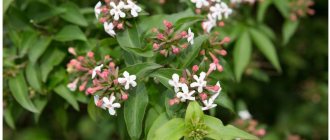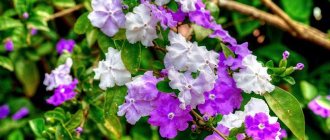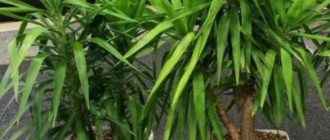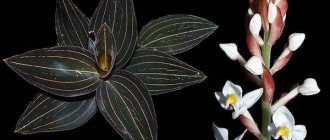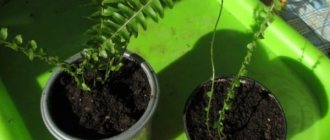In this article, the Site will tell you about the types of dracaena and how to care for it at home: placement, watering, temperature conditions, etc.
- Types of dracaena
- Accommodation
- Watering
- Temperature
- Humidity
- Top dressing
- How to trim
- How to propagate
- How to replant
- Pests and diseases
- Site Digest
Recently, landscaping at home is not just a trend, but an obligatory component of any interior. Beautiful, stylish and useful. Plants look original in compositions, but individually they do not lose their charm. Let's take a closer look at one of these - dracaena.
A spectacular representative of the asparagus family, it grows in nature mainly in tropical and subtropical regions. In her homeland, her name is translated as “female dragon.” This is due to the color of the sap that the plant produces. The dark red gum reminded our ancestors of dragon's blood.
Externally, the plant resembles a palm tree, sometimes a shrub. Most often it has a tree-like shape; the trunks of natural species can reach a diameter of up to 2 meters. Dracaena leaves are dense, linear, lanceolate or belt-shaped, and also oval.
When choosing a plant for your home, you need to consider how much space and light you can provide it with. Among the variety of species there are both giant and compact dracaenas. And if a young plant takes up little space, then an adult plant grows and requires more comfortable conditions. Likewise, different foliage requires different lighting conditions.
Types of dracaena
There are more than 150 plant species. But the most popular for the interior are the following dracaenas:
1. Fragrant - a shrub with arched glossy leaves. They are quite large, growing up to 70 cm in length and 10 cm in width. Varieties of fragrant dracaena are distinguished by the color of the leaves, the size and color of the stripes on them. There are solid green leaves, variegated with a border around the edges or with a couple of stripes. Their color varies from white to yellow. The flower got its name from its delicious aroma during flowering.
2. Marginata (fringed) - a small tree slightly reminiscent of a palm tree. The trunk is smooth and straight, the leaves are hard, linear with pointed ends. In nature, this is a very large, powerful tree, but people have domesticated small cuttings of the trunk, which look no worse and grow up to 2-3 meters. Along the edges of the leaves of dracaena there is a narrow border, most often of a reddish tint, but you can also find yellowish stripes.
3. Deremskaya - a tall tree with a thick tree trunk. Outwardly it is similar to fragrant dracaena, but its aroma when flowering is unpleasant. The leaves are large, lanceolate with yellow, gray, white or green stripes. Their length can reach up to 50 cm, and their width is about 5 cm.
4. Sandera is a bamboo-like plant that, according to Feng Shui, brings good luck and prosperity. This dracaena is perennial; at home it can reach a height of a meter or more. Its gray-green leaves are slightly twisted and grow up to 25 cm in length.
5. Hookera - South African tall dracaena, most often cultivated in greenhouses or in houses with high ceilings. It grows above 2-3 meters, and there are specimens with a bifurcating trunk. Green leaves with light edges grow up to 100 cm long and up to 10 cm wide. They themselves are dense, leathery, slightly tapering at the base.
6. Reflexa (bent) - the most capricious of dracaenas. It grows slowly, needs support and high humidity. With good care it will grow up to 3 meters in height. The leaves are small, arrow-shaped and slightly curved. The edges are painted with a yellow stripe.
7. Godsefa (surculosa) - dracaena-shrub, not similar to the above, but no less picturesque. It produces its new shoots not from the trunk, but directly from the ground. With careful care, it will grow at least a meter and will delight you with pleasant fragrant flowering. Its leaves are more oval, slightly wavy at the edges and slightly pointed at the base. The main color is green; the pattern on the leaves decorates the plant not with stripes, but with a large number of white or yellow spots. With age, the leaves will begin to turn white.
Terms and rules of transplantation
Planned replanting of dracaena is carried out every year for young bushes and once every 2-3 years for adult specimens. The optimal time is mid-spring, when active growing season begins and Godsefa needs to renew the soil and a larger diameter container. The bushes are replanted using the transshipment method, without exposing the root system. This minimizes the loss of suction roots. At the bottom of the bowl, drainage must be made of expanded clay or small stones. The soil for planting dracaena should be loose, with a neutral pH level.
Store-bought dracaena is replanted after 2 weeks, as soon as the flower adapts to new conditions. In case of root rotting or fungal infection, an emergency transplant is carried out regardless of the time of year. Damaged roots are removed, sprinkled with activated carbon and placed in disinfected soil.
The diameter of the pot should be 1.5 times smaller than the diameter of the bush. A container that is too spacious will cause slow growth of shoots.
Even the laziest gardener can grow Dracaena Godsef at home. The perennial requires minimal care, yet has an attractive, decorative appearance. The exotic coloring of the leaves, characteristic of popular varieties, can become a highlight in the interior of any room.
Accommodation
Dracaena has appeared in your house. Where should it be placed? Any room or insulated balcony is suitable for growing. The ideal option is to place it near an east or west window , but the plant should be kept away from the south. Dracaenas love good lighting, but not direct sunlight. The latter burn spots on the leaves. Try to find a place where the plant will be comfortable.
Experiment, play with the position: look at different areas of the room or place it in another. Do not bring them close to the wall either; the ends may dry out from contact. Artificial light is also suitable for growing dracaena. Often it is necessary to organize lighting in such a way that the crown of the plant is illuminated evenly.
The main principles of home care for dracaena
Dracaena cultivated indoors requires the creation of certain conditions for its own development. You need to take care of the plant comprehensively, performing the following activities:
- maintaining optimal temperature conditions;
- air humidity level control;
- proper lighting;
- compliance with watering rules;
- effective fertilizing.
Below is a detailed description of each stage.
Temperature
If dracaena appears in your flower collection, caring for it at home involves maintaining a moderate atmospheric temperature. In summer, temperature indicators in the place where dracaena grows should vary within +18+25 ºC. Recommended winter temperature: +15 ºC.
We recommend viewing: Indoor palm tree - varietal varieties and care rules
With the onset of warm spring days, take the plant outside more often. Try not to leave the crop in a windy area, as strong drafts impair the quality of development of the ornamental plant. Do not leave the flower on an open window, and in the summer heat, try to spray it regularly and water it more often. Dracaena, the care of which must be comprehensive, is generally unpretentious to growing conditions. It is grown in the home or used to decorate office spaces.
Air humidity
When dracaena grows on your windowsill, caring for it at home requires maintaining high air humidity. Representatives of the genus do not like a dry atmosphere, so they should be sprayed twice daily. In the absence of such a procedure, the leaves of the crop will soon turn yellow and fall off.
The leaves of the plant quickly become covered with dust, and if dracaena “lives” in your house, caring for it also involves regularly wiping the leaf plates with a damp cloth. In general, it is better to rinse specimens of the Durham variety in the shower.
Among all the varieties of the crop, the Dragon and Godsefa varieties are the most unpretentious to growing conditions. They retain their decorative appearance even when in a room with dry air.
Lighting
Regardless of the type of dracaena, caring for the crop involves providing suitable lighting conditions. Direct sunlight is harmful to her. The plant prefers to grow in an area that is well lit. Therefore, the ideal option for placing the culture is the western or eastern side of the room. Dracaena varieties with dark leaf colors do not need a lot of light. But variegated varieties, in the event of a lack of light, lose their beautiful coloring. Therefore, they need to provide a sufficient level of illumination. A florist can provide dracaena care at home and using artificial light. The culture grows more actively if it is placed in a room with a constant abundance of light. Penumbra inhibits flower development, making the process slower.
Watering
The soil should have time to dry sufficiently between waterings. Not completely, but half the pot, check with a simple wooden stick or knitting needle. Usually in the warm season the plant is watered once a week , and in winter once every two weeks is enough. But you shouldn’t overdo it with watering; from stagnation of liquid, the plant withers and the roots rot.
Water for irrigation is used tap water, settled or filtered. Once a month, you can give your dracaena a “hot shower” procedure ; the tropical plant will appreciate it and be saturated with moisture. During the shower, so as not to wash away the soil and not to oversaturate the plant with water, cover the pot in a bag and secure the edges. For those who are familiar with this type of watering, you can do without covering the soil. The shower is set to medium or low power, the water is turned on at 60-70 degrees (this is when it’s hot, but your hand can tolerate it) and watered evenly, without getting carried away, for 20-30 seconds. And then they leave it in the shower for two or three hours without turning off the light. You can leave it overnight.
Humidity
To prevent the plant from drying out, a certain humidity is maintained in the house. Only Godsef calmly tolerates dry air from dracaenas; for everyone else, you need to stick to 60% . They especially often humidify the air when the heating is on.
If you see that the plant has begun to fade a little, watering it with a “hot shower”, which we wrote about just above, will help bring the plant back to life. The main thing is to leave the dracaena longer after bathing to saturate itself with the evaporation of moisture. If possible, you can purchase a humidifier.
Top dressing
For dracaenas, feeding is required. Lack of nutrition, especially nitrogen, causes yellowing of the leaves. Therefore, during the growth period - from March to September - it is watered twice a month with complex fertilizers for indoor plants. Do not look for special fertilizers for dracaenas, look at the NPK ratio (nitrogen, phosphorus, potassium), it should be 3:1:3 . Periodically, you can spray with epin or iron chelate.
Feeding Draceni
When cultivating dracaena, home care includes effective feeding. When the crop begins to grow intensively, add fertilizer to the soil. The period of active development in dracaenas lasts from March to August. The recommended amount of fertilizing is 2 times a month.
At other times, dracaena also needs feeding, but not so often. It will be enough to fertilize the soil at the planting site once every 30 days. Basically, complex fertilizers are required, but variegated varieties of crops require specialized formulations.
We recommend viewing: Home begonia: planting, care, varietal varieties
How to trim
When plants become stretched and lose their outer beauty, they need pruning. It is carried out with a very sharp and disinfected knife . Measure 20 cm from the top of the trunk and cut it at a right angle, immerse the end of the cut in a rooting agent and plant it in a mixture of vermiculite and perlite (drainage is placed at the bottom of the pot). Then cover the cuttings with a greenhouse, any bag will do, and leave for 30 days.
Water such cuttings once a week in a tray without opening it. Cuts on dracaena hemp are treated with crushed coal, cinnamon, or better yet, melted paraffin. Otherwise, they may rot or begin to dry out. You can cover the stump with moss and wrap it in polyethylene, this will help the cut grow faster. After some time, new shoots will appear on the stump. And little by little the beauty of the old dracaena will be restored.
How to propagate
Dracaena propagation occurs by cuttings or growing from seeds . The most favorable time is from February to May.
The seeds are soaked in water for 24 hours, and a stimulant is added if desired. Plant in a container with a diameter of no more than 10 cm, in the ground 1-2 cm from the surface. The soil must be sterilized before planting. The soil is taken special for seedlings or universal. Then cover it with a greenhouse (bag, jar) to increase humidity, open it a couple of times a day. Seeds germinate from 2 weeks to 3 months. With cuttings, the rooting procedure is the same, cut off 7-10 cm of the stem and plant it in the ground. Some gardeners also root in water, but this method takes even more time.
Varieties
The most popular type is dracaena marginata or another name for marginalia. This variety has a strong trunk and the plant can reach up to 3 meters in height.
The leaves are long and narrow, dark green in color. Marginata grows quite slowly, over the course of a year it will grow by about 10 cm, and at home it is very rare to see flowering.
There are several varieties of dracaena, which differ from each other in the color of their leaves.
Dracaena godsefa - this variety differs not only in the color of the leaves, but also in the growth of the stems. The leaves of this flower are oval with pointed ends, the color is dark green with yellow or pale spots. If this species is properly cared for, it can grow up to 1 meter.
Dracaena reflexa (reflexa) - the plant has curved arched leaves of a bright green color. This species has a weak stem. It blooms quite rarely at home.
Dracaena derema is a very beautiful tree with a woody trunk. This species grows up to three meters in height. The plant has wide and hard leaves with golden or white longitudinal stripes. In its natural environment, this variety blooms with large red flowers.
Dracaena fragrant - this variety is the largest. The tree grows up to 6 meters in height, and the length of the leaves can reach up to 80 cm and the width is about 3 cm. The leaves are glossy and hard. The flowers are fragrant, white and yellow. At home, fragrant dracaena practically does not bloom.
How to replant
Over time, the soil changes structure, becomes compacted, caked, and the roots do not receive enough oxygen. To avoid this, a transplant is needed. It is held in the spring. Select soil special for dracaenas or mix the soil yourself (in equal proportions - turf, leaf soil, compost and fine gravel); drainage must be placed at the bottom of the pot.
If the plant is less than three years old, replant it every year. Adults, large and slow-growing ones are replanted every couple of years. For very large plants, such as adult dracaenas, replanting is carried out in extreme cases, but the top soil is changed once a year.
You should not immediately replant a purchased plant; let it adapt a little. During the period of flowering and disease, replanting is also not recommended.
Pests and diseases
Typically pests that attack dracaena are scale insects, thrips and whiteflies. Rarely spider mites and aphids. The plant is quarantined, pests are removed and treated with special preparations (insecticides).
As for diseases, they affect dracaena:
- powdery mildew;
- horny, gray, brown and bacterial rot;
- fusarium, bacteriosis, heterosporosis;
- spotted wilt and some others.
For treatment, damaged leaves and areas are removed , treated with special solutions or replanted. Each case is individual and sometimes require quite a long time. Be patient, follow the recommendations of experts, and you can save your dracaena. In the future, follow the care tips, and then many diseases will be avoided.
Pests and diseases of dracaena
Dracaena most often suffers from attacks by scale insects and thrips. Shedding of the lower leaves is considered natural for representatives of the genus. However, yellowed edges of the leaf blades indicate that the crop lacks moisture. Therefore, if such a problem occurs, increase the number of sprays of the plant. Do not expose the flower to direct sunlight, which will cause dark burns on its leaves.
A spider mite that settles on the surface of dracaena leaves sucks the juice out of them and provokes their rapid shedding. Another trouble that owners of the culture have to face is the drying out of the foliage as a result of the appearance of brown spots on it. It occurs against the background of dry air in the room or a lack of moisture in the ground.
Site Digest
Know and be able to: how to grow orchids - We will tell you how to grow and care for several types of indoor orchids at home, which are often sold in stores.
Buying indoor plants: step-by-step instructions. — We buy indoor plants that will grow and delight us for many years. The site will tell you how to make the right choice!
9 cool plants for the home and how to properly care for them - We’ll tell you how to choose simple indoor plants with recommendations for growing different types of indoor plants. Which ones will you choose?
How to repot houseplants - is it time to repot houseplants? We'll tell you and show you how to do it correctly and usefully for our green friends!
11 plants that purify the air in the apartment - Let's talk about 11 plants that purify the air in the apartment and create a pleasant atmosphere. Description of the beneficial properties of plants for your health and home. Beautiful, natural and healthy!
Botanical description of the plant
Godsefa (also known as Dracaena surculosa) is a tropical subshrub native to West Africa. In open ground it grows up to 8 m in height, blooms annually and produces bright orange fruits. At home, the length of the shoots depends on the variety and rarely exceeds 1 m.
Leaves on thin petioles appear directly from the ground, for which the plant is often called shoot-forming dracaena. Unlike other varieties, Godsefa has oval-shaped leaf blades covered with a large number of cream-colored spots. On the back side the leaves are green in color. The roots are smooth, terracotta in color, without knots.
Several varieties of dracaena Godsef are grown at home:
- Punctulata is a variety with small rings of a lighter shade on dark green elongated leaves. A rare variety, mainly grows in open ground.
- Milky Way is one of the most popular varieties. In the center of the leaf there is a white stripe surrounded by many light specks. The whimsical design resembles the Milky Way. This feature determined the name of dracaena.
- Juanita - looks similar to the previous variety, but the pattern is not as clear and the central stripe is much narrower.
- Florida Beauty is a variety of dracaena that is characterized by the largest number of cream dots on the foliage. The center of the shoot often turns completely yellow. With age, the spots become whitish.
According to the description and external characteristics, Godsefa resembles another indoor plant - cordyline. You can distinguish dracaena by its roots. In Cordelina they are white, with many nodules.
Florida Beauty
Juanita
Milky Way
Punctulata
